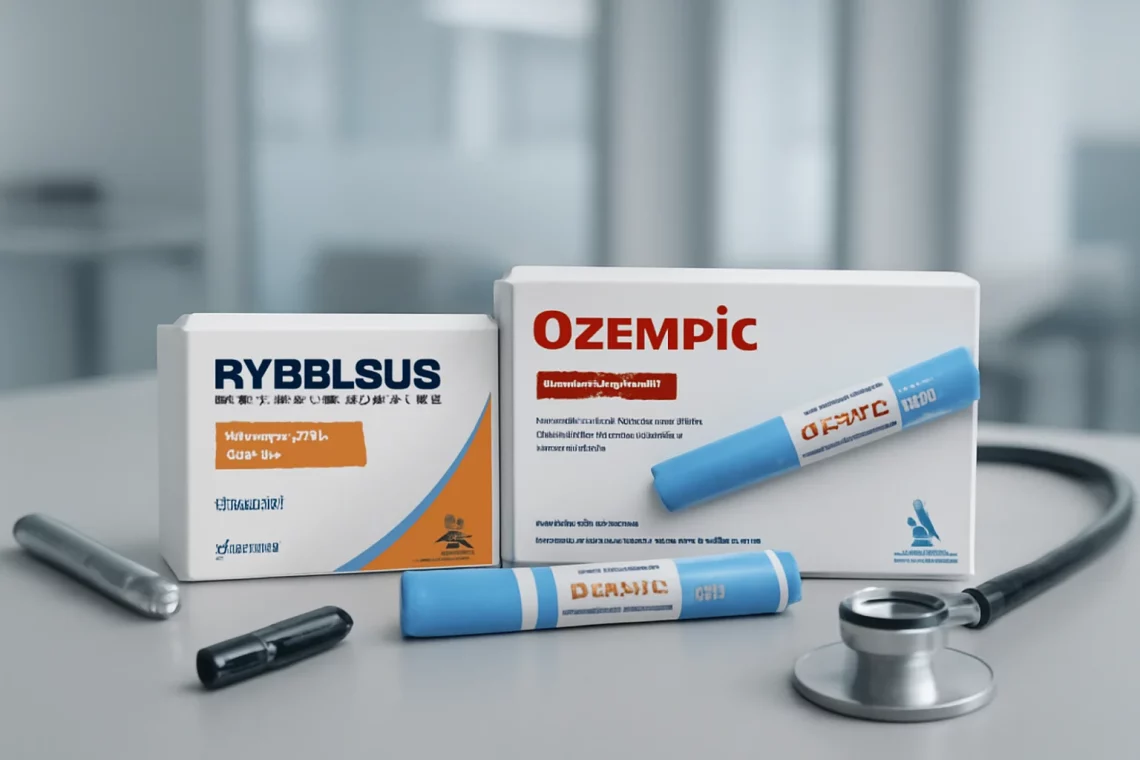
Rybelsus vs Ozempic: Which Diabetes Treatment is Right for You?
In recent years, the conversation around diabetes management has evolved significantly, with a focus on innovative medications that offer new hope to individuals living with Type 2 diabetes. Among these medications, Rybelsus and Ozempic have emerged as prominent players in the landscape of diabetes treatment. Both belong to a class of drugs known as GLP-1 receptor agonists, which mimic the actions of the glucagon-like peptide-1 hormone. This hormone plays a crucial role in regulating blood sugar levels and appetite, making these medications vital for those struggling to maintain optimal glucose control.
As the prevalence of Type 2 diabetes continues to rise globally, understanding the differences and similarities between such medications becomes essential. Patients and healthcare providers alike are tasked with navigating a myriad of options, each with unique benefits and potential drawbacks. The choice between Rybelsus and Ozempic can significantly impact a patient’s treatment journey, influencing not only their blood sugar management but also their overall quality of life. With both medications designed to complement lifestyle changes and dietary modifications, the decision-making process is multifaceted and requires careful consideration.
This discussion invites a closer look at Rybelsus and Ozempic, exploring their mechanisms of action, effectiveness, side effects, and other critical factors that can guide treatment choices for individuals living with diabetes.
Mechanism of Action
Understanding how Rybelsus and Ozempic work is fundamental to appreciating their roles in diabetes management. Both medications are classified as GLP-1 receptor agonists, but they differ in their formulation and method of administration.
Rybelsus is a unique oral medication, making it the first of its kind in the GLP-1 receptor agonist category. It is taken in pill form, which can be more convenient for patients who prefer not to use injections or who have a fear of needles. Once ingested, Rybelsus works by stimulating insulin secretion from the pancreas in response to meals while simultaneously suppressing glucagon secretion, a hormone that raises blood sugar levels. This dual action helps to lower blood glucose levels post-meal, making it particularly effective for glycemic control.
Ozempic, on the other hand, is administered via a once-weekly injection. By delivering the medication directly into the body, Ozempic provides a steady release of the active ingredient, allowing for sustained control of blood sugar levels. Similar to Rybelsus, Ozempic promotes insulin secretion and reduces glucagon levels, but the extended-release formulation may lead to more stable blood sugar levels over time.
Both medications also have a significant impact on appetite regulation, which can contribute to weight loss—an important factor for many individuals with Type 2 diabetes. By slowing gastric emptying, they help patients feel fuller for longer periods, thereby reducing overall calorie intake. This effect can be particularly beneficial in the context of managing both diabetes and obesity, as weight loss can improve insulin sensitivity and overall health outcomes.
In conclusion, while Rybelsus and Ozempic operate on similar principles, their differences in administration and formulation can influence patient preference and adherence to treatment. Understanding these mechanisms is crucial for individuals considering their options in diabetes management.
Effectiveness in Blood Sugar Control
When it comes to selecting a diabetes medication, effectiveness in blood sugar control is a primary concern for both patients and healthcare providers. Rybelsus and Ozempic have been shown to significantly improve glycemic levels, but their efficacy can vary based on individual patient factors.
Clinical studies indicate that both medications can lead to substantial reductions in hemoglobin A1c (HbA1c) levels, a key marker used to assess long-term blood sugar control. Ozempic has demonstrated a more pronounced effect on HbA1c reduction in some studies, often achieving a decrease of more than 1.5% after a few months of treatment. This level of efficacy can be particularly advantageous for patients with higher baseline HbA1c levels, as more substantial reductions can lead to improved health outcomes.
Rybelsus, while slightly less potent in terms of HbA1c reduction, still provides significant benefits, with studies showing reductions of approximately 1-1.5%. The oral administration of Rybelsus can also be a deciding factor for many patients, as it may enhance adherence for those who struggle with injections.
Moreover, both medications have shown effectiveness in promoting weight loss, which is crucial for many individuals dealing with Type 2 diabetes. The ability to lose weight not only aids in diabetes management but also reduces the risk of developing other complications associated with obesity, such as cardiovascular issues.
Patient experiences can vary, however, and what works effectively for one individual may not yield the same results for another. Therefore, it’s essential for patients to collaborate with their healthcare providers to monitor blood sugar levels and adjust treatment plans as necessary.
In summary, both Rybelsus and Ozempic have proven effective in managing blood sugar levels, but the choice between the two may depend on individual preferences and specific health needs. Ongoing monitoring and adjustments will be key to achieving optimal results in diabetes management.
Side Effects and Considerations
Like all medications, Rybelsus and Ozempic come with potential side effects that patients should consider when making treatment decisions. Understanding these side effects can help individuals weigh the benefits against the risks associated with each medication.
Common side effects for both Rybelsus and Ozempic include gastrointestinal issues such as nausea, vomiting, diarrhea, and constipation. These symptoms are often more pronounced during the initial phase of treatment as the body adjusts to the medication. For many patients, these side effects tend to diminish over time, but they can still pose challenges, particularly for those who may already have sensitive digestive systems.
In the case of Rybelsus, patients may also experience a higher incidence of gastrointestinal discomfort due to its oral formulation. Some individuals may find that taking the medication with a larger glass of water or adjusting the timing of their doses can alleviate some of these symptoms.
Ozempic, being an injectable medication, may also present concerns regarding injection site reactions such as redness, swelling, or itching. While these reactions are generally mild and temporary, they can deter some patients from adhering to their prescribed treatment regimen.
Another critical consideration is the potential risk of pancreatitis, a serious inflammation of the pancreas. Although rare, both medications carry this risk, and patients experiencing severe abdominal pain should seek immediate medical attention.
Weight loss, while often a desired effect, can also be a double-edged sword. Some patients may experience excessive weight loss, leading to health complications. Therefore, it’s vital for individuals to regularly communicate with their healthcare providers about their experiences and any side effects they encounter.
Ultimately, the decision to use Rybelsus or Ozempic should involve a thorough discussion of potential side effects and considerations tailored to each patient’s unique health profile. This collaborative approach will help ensure that the chosen treatment aligns with the individual’s health goals and lifestyle.
Cost and Accessibility
When choosing between Rybelsus and Ozempic, cost and accessibility are significant factors that can influence treatment decisions. Both medications can be expensive, and their availability may vary based on insurance coverage and pharmacy options.
Rybelsus, being a newer oral medication, may come with a higher price tag compared to more established diabetes treatments. Patients should check with their insurance providers to understand coverage options, including co-pays and deductibles, that may affect out-of-pocket costs. Many pharmaceutical companies also offer patient assistance programs that can help reduce the financial burden for eligible patients.
Ozempic, while generally available through most pharmacies, can also be costly, particularly for those without insurance or with high deductibles. Similar to Rybelsus, it is advisable for patients to explore assistance programs offered by the manufacturer.
Comparing copayment structures between the two medications is essential, as some insurance plans may favor one over the other based on formulary status. For patients who are cost-sensitive, discussing alternatives with healthcare providers can lead to discovering other effective medications that may be more affordable.
Accessibility also extends to the administration method. For some patients, the idea of self-injecting may be daunting, which could lead to a preference for Rybelsus. Conversely, others may find the convenience of a weekly injection easier to manage than a daily oral medication.
In summary, cost and accessibility play a pivotal role in the decision-making process for individuals considering Rybelsus or Ozempic. Patients should work closely with their healthcare providers and insurance representatives to navigate these factors effectively.
In conclusion, while Rybelsus and Ozempic offer valuable options for managing Type 2 diabetes, the choice between them should be guided by individual preferences, effectiveness, side effects, and financial considerations. Patients are encouraged to consult their healthcare providers for personalized advice and treatment plans that align with their unique health needs.
**Disclaimer**: This article is for informational purposes only and does not constitute medical advice. Always consult with your healthcare provider for any health-related issues or concerns.




